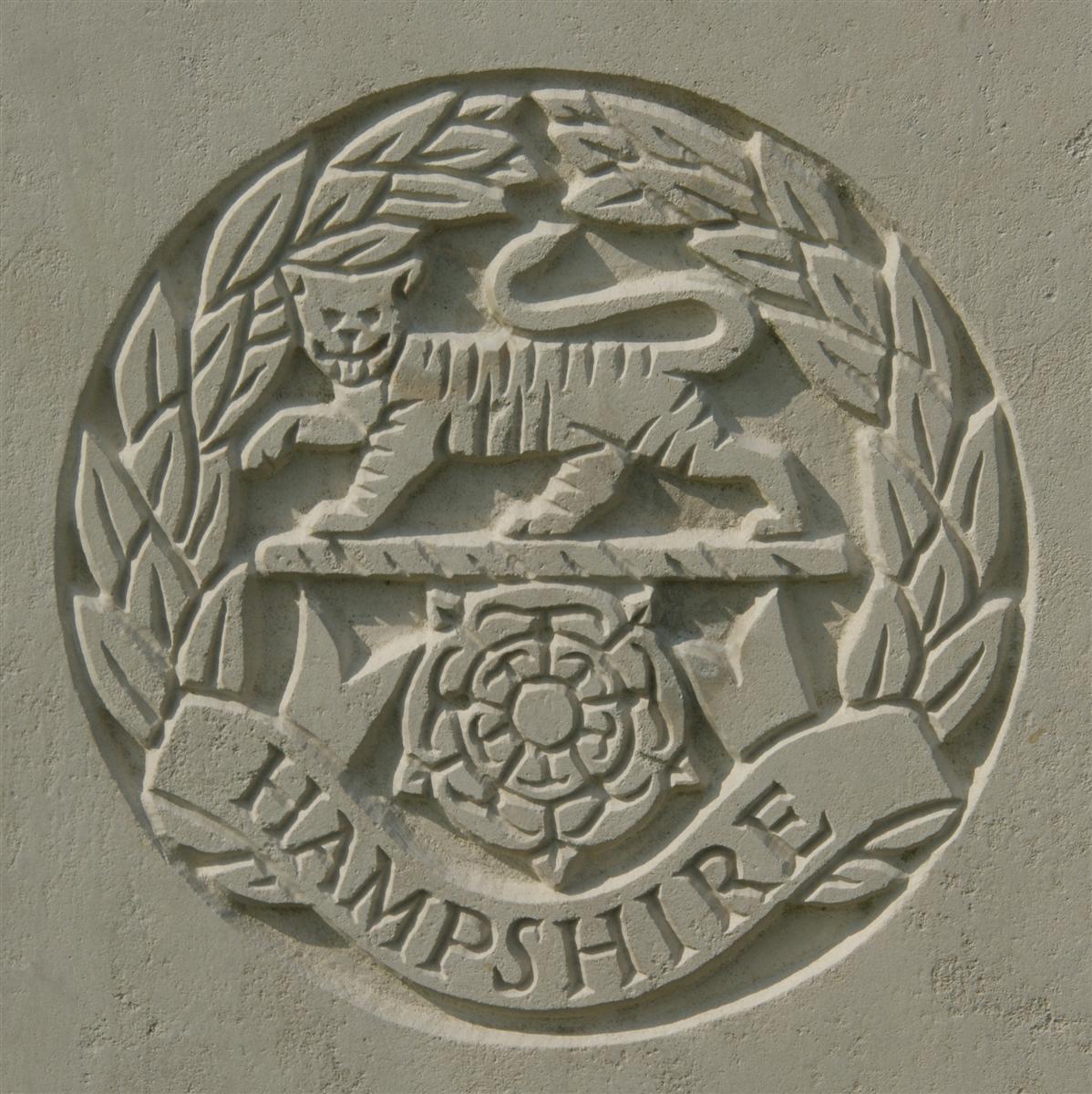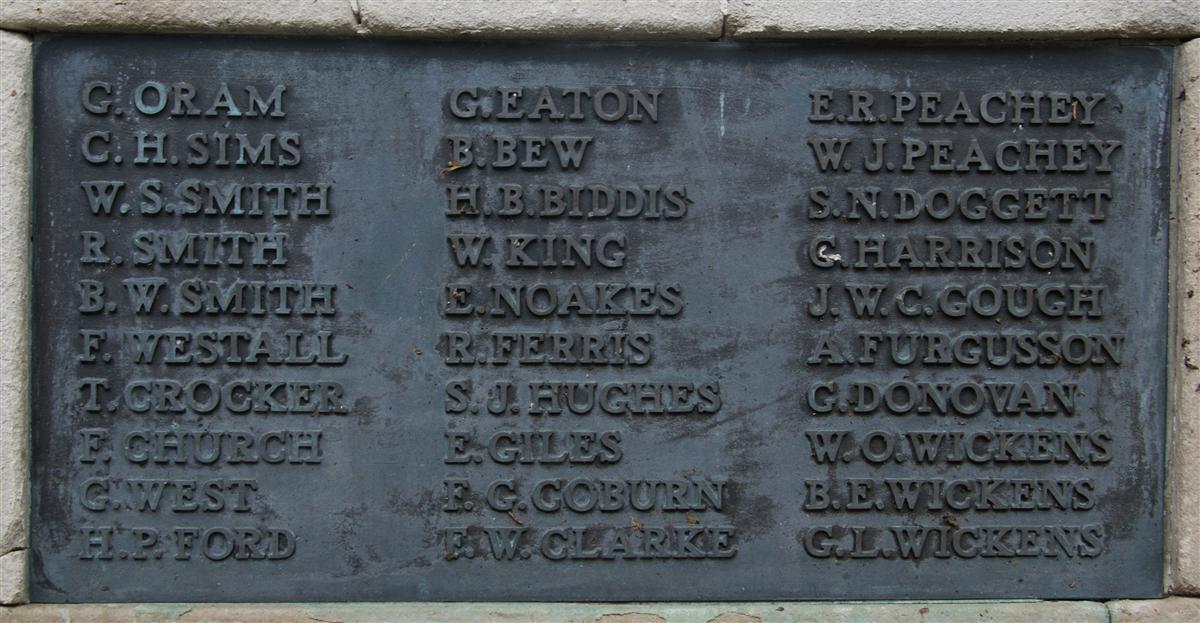Henry Percy Ford
Lance Corporal 7056 Henry Percy Ford, 1st Battalion, Hampshire Regiment
Percy was born in Basingstoke in 1887 the youngest son of Charles Ford and his wife Sarah (née Coles). His father died in 1886, before Henry was born, leaving Sarah pregnant with seven children to care for – two further children died in infancy. Sarah worked as a tailoress in Basingstoke in order to support her large brood – the eldest child Elizabeth was 11, so it would be a couple of years before she would leave school and start to contribute to the family budget. By 1891 young Elizabeth was also working as a tailoress and the next child, Thomas, aged 14, was working as a tailor’s assistant. The remaining children, George (13), Harriet (12), Sarah (8), Charles (7), Daisy (6) and Percy (4) were yet to enter the labour market. Ten years later the 14-year-old Percy was working as an errand boy, a typical first job for lads in a country town like Basingstoke. Sarah appears to have retired as she gives no occupation in her census return, there was, however a 2-year-old ‘nurse child’, Queenie Maguire, in the household. Fostering a child may well have been another way to increase the family income.

The regimental badge of the Hampshire Regiment, as used on CWGC headstones. |
Back in civilian live Percy got a job as a farm labourer in Hurstbourne Tarrant, where he lodged with Thomas Warwick a gardener and his wife Elizabeth. A second boarder, Albert Fishlock, was working as a chauffeur; perhaps they were all employed by a local estate?
In late 1913 Percy married Gertrude Anne Watts from St Mary Bourne (a short distance down the Bourne Valley from Hurstbourne Tarrant). The couple moved to Newbury in 1914 when they moved into 2 West Street, no doubt the result of a change of Percy’s employment.
When war broke out in 1914 Percy was still in the Reserve and would have been mobilised for service immediately. The Hampshire’s 2nd Battalion was in India in August 1914 while the 1st Battalion was stationed in Colchester, so their Reserves were called up to bolster the strength of the 1st Battalion. Nine days after the declaration of war the 1st Battalion crossed over to France, landing in Le Havre on 23 August. Percy was not with the Battalion for the crossing, he arrived in France four days later, no doubt with a group of fellow Reserves who had not caught up with the Battalion earlier.
The 1st Battalion’s first action came at the Battle of Le Cateau where the newly arrived 4th Division (including the Hampshires) joined the exhausted II Corps, who had been retreating since the Battle of Mons three days earlier, and faced the advancing Germans. Although massively outnumbered the British troops managed to hold up the Germans and inflict very heavy casualties. The retreat then continued until 7 September, when the French launched a counter offensive at the Marne and, aided by the British, started to push the Germans back.
In mid October the Germans determined to stop falling back and to stand and fight, and to attempt outflanking manoeuvres to try to turn the tide back in their favour. All around the Belgian town of Ypres there was desperate fighting as the two sides each attempted to seize the initiative. This led to numerous crises, including one near the village of Messines (Mesen).

The ruins of Ypres' mediaeval Cloth Hall. painted by Major James Kerr-Lawson |
The situation can be seen from the terse description of the period in the battalion’s war diary:
1st Hampshire Regiment War Diary (TNA:WO 95/1495)
30th Oct |
At 6.30am the Germans commenced a terrific bombardment lasting until 4.30pm, when the German infantry commenced to advance to the attack. On our opening fire the enemy could make but little progress and the attack practically ceased till dusk. Owing to some dead ground the enemy were able to work their way close up to C Coy’s line, and it was during the advance that Capt Harland was killed by MG fire. Lt Trimmer was holding a trench some 20 yards in front of the main line and suffered heavy losses from the German guns & MGs both of which were concentrated on his trench. During the bombardment Lt Trimmer was killed. |
31st Oct |
Our position was again incessantly bombarded from dawn till 4pm. The enemy attacked and succeeded in gaining a trench occupied by No 10 Platoon (C Coy). This platoon held out against vastly superior numbers, but eventually were overpowered and only one man, and orderly who was sent back, remaining alive in this platoon. |
1st Nov |
During the night 31st-1st, 3 platoons of C Coy were relieved by the SLI [Somerset Light Infantry]. Heavy bombardment continued and the enemy attacked along the whole of our line. |
2nd Nov |
The enemy again made desperate attempts to break through our line. We had a large number of casualties, but succeeded in keeping the line intact. |
At some point in these desperate four days Percy lost his life. He has no known grave so he could well be one of those anonymous ‘Other Ranks’ marked down as ‘missing’; perhaps he was part of the desperate but ultimately futile defence of 10 Platoon’s trench, perhaps he was just the victim of shellfire as he waited for the bombardment to stop and the fighting to begin again.
The news of his death reached Newbury:
Newbury Weekly News, 24 December 1914 – Local War Notes
The sad news has been received at 2, West-street of the death in action, between the dates of Oct 30th and Nov 2nd, of L/Cpl Henry Percy Ford, who, on the outbreak of war, rejoined his regiment, the 1st Hants, then under orders with the first British Expeditionary Force. Many who knew the deceased will sympathise with Mrs Ford in her sad bereavement.

Percy's name on Newbury War Memorial (bottom left) |
Percy is remembered on panel 6 of the memorial to the missing at Ploegsteert (known by the Tommies as Plugstreet).
Locally he is commemorated on Tablet 11 of the Newbury Town War Memorial, and on the parish memorial board and roll of honour in St Nicolas’ Church.
Gertrude remained in Newbury, moving out of 2 West Street, but only as far as 8 West Street. She died in 1930; they had no children.
Thanks to Karen Newbery for her help researching this soldier.

